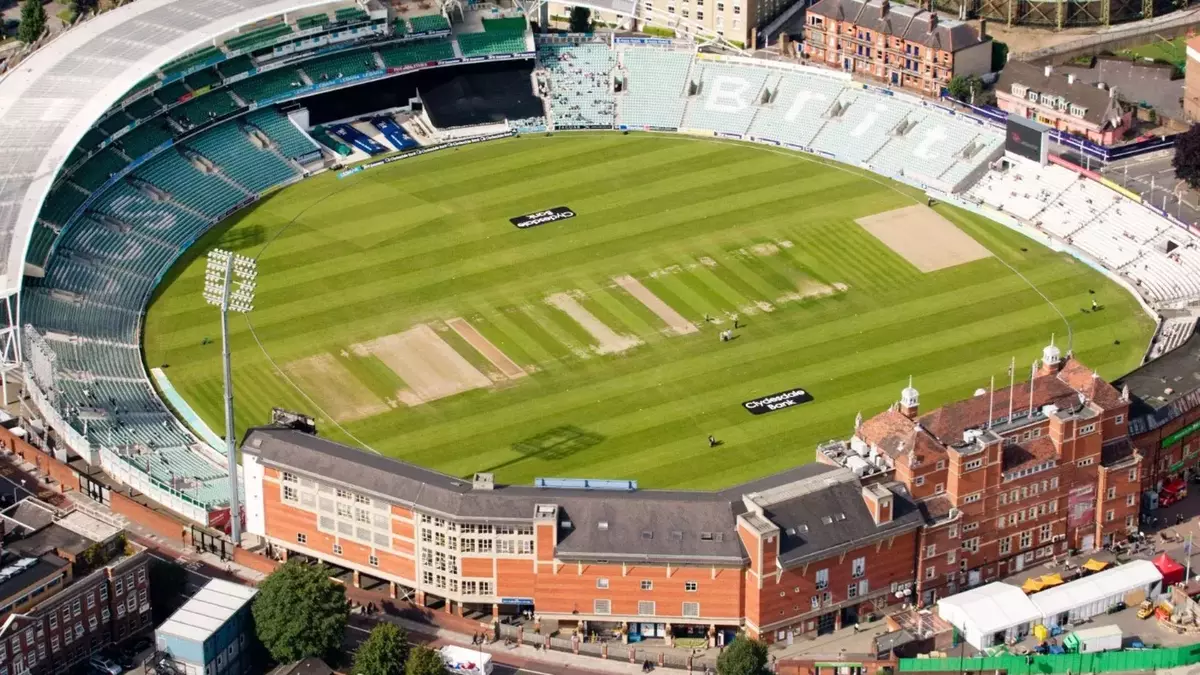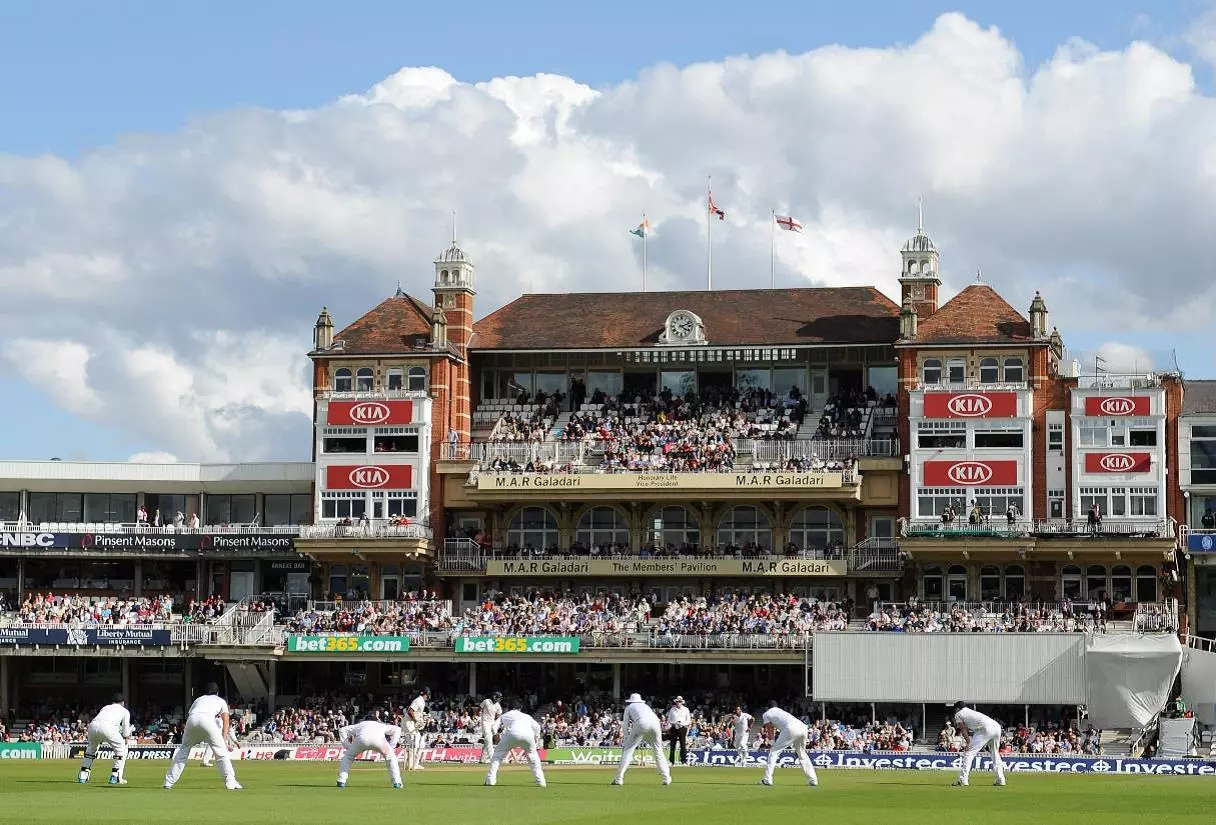
Stands on Kennington, south London, The Oval is an iconic cricket ground that has etched its name in the annals of sporting history.
As the home of Surrey County Cricket Club, the Ashes series, also numerous iconic matches, The Oval is one of the most the oldest grounds, and legendary cricket grounds in the world.
The Oval: The Old Ground That Still Standing

As the home ground of the Surrey County Cricket Club since 1845, The Oval in South London is also the home of many iconic cricket moments.
While the pitch itself batsman friendly, many records and achievement are already broken on these field. Here are some of key point about The Oval to consider:
Summary & Key Takeaways
ShowHistory and Story of The Oval
- Establishment: Established in 1845 by Surrey County Cricket Club.
- First Test Match in England: Hosted the first Test in England in 1880.
- Ashes Origin: Linked to the origin of the Ashes series.
- Development Over the Years: Undergone several renovations; includes a notable pavilion.
- Iconic Matches and Events: Hosted various historic matches and events.
- Modern Era Innovations: Innovated with night matches and Twenty20 format.
- Cultural Impact: A cultural landmark reflecting cricket's evolution.
Capacity Changes
- 2005 Development: Increased capacity to 23,000.
- 2014 Expansion: Added 500 seats in each 'wing' of the OCS Stand.
- 2016 Addition: New Peter May Stand increased capacity to 25,300.
- Future Plans: Intends to increase capacity to 40,000 by 2023.
Pitch Condition
- Test Matches: Initially batsman-friendly, later aiding spinners.
- ODIs: High-scoring; slows down in the second innings.
- T20Is: Balanced for batsmen; dew factor in night matches.
Iconic Moments
- Historic Matches: Listed from the first FA Cup Final to the 2010 spot-fixing scandal.
- Importance: These moments underline The Oval's historic significance.
Location and Visiting Tips
- Address: Kennington Oval, London SE11 5SS, UK.
- Tours: Offers guided stadium tours.
- Transportation: Accessible via public transport; limited parking available.
- Bike Parking: Limited bike parking at the Hobbs Gate.
Architecture and Design
- Major Redevelopment: Completed in 2005; increased capacity.
- Design Team: Led by The Miller Partnership.
- Construction Phases: Two phases, with a focus on functionality and aesthetics.
- Recent Developments: Installation of telescopic floodlights in 2009.
- Future Plans: Expansion plans announced but not fully realized.
Final Words
- Summary: The Oval is a testament to the evolution of cricket, blending history with modernity, making it a cherished destination for cricket fans.
The History of the Oval
The Oval, also known as the Kia Oval due to sponsorship reasons, is an international cricket ground in Kennington, South London.
It has a rich history and has played a significant role in the development of cricket.
The Oval was established in 1845 by the Surrey County Cricket Club. Its land was leased from the Duchy of Cornwall and was originally a market garden.
The ground is historically significant as it hosted the first-ever Test match in England in 1880 between England and Australia.
This landmark event marked the beginning of a long tradition of international cricket at the venue. The Oval is intrinsically linked with the Ashes series between England and Australia.
It was after a match at The Oval in 1882, which England lost, that a mock obituary was published in ‘The Sporting Times‘ stating the death of English cricket, and the body would be cremated and the ashes taken to Australia. This led to the creation of the Ashes urn trophy.
The Oval has undergone numerous developments and renovations over the years. It was one of the first sports grounds to have a gymnasium and a swimming pool.
The pavilion, built in 1890, is a notable feature and is known for its distinctive gables and historic architecture.
Apart from cricket, The Oval has hosted various other events, including the first-ever FA Cup Final in 1872 and international football matches.
In cricket, it has been the scene of many famous matches, including Don Bradman’s last Test innings in 1948.
In the modern era, The Oval has continued to innovate, hosting night matches and embracing newer formats like Twenty20. It remains a key venue for domestic and international cricket, with a capacity of around 25,000.
The Oval is not just a cricket ground but a cultural landmark in London. It has witnessed the evolution of the sport and reflects the social and historical changes in the game and society over the decades.
Ground Capacity
The capacity of the Kennington Oval cricket ground has undergone several changes over the years, reflecting its development and modernization. Here’s a summary of the notable changes in capacity:
At the end of the 2002 cricket season, Surrey started redeveloping the Vauxhall End, which included demolishing outdated stands and creating a new four-tier grandstand, known as the OCS Stand (later renamed the JM Finn stand).
This redevelopment was completed in May 2005, increasing the ground’s capacity to around 23,000.
After the 2013 season, ‘wings’ were added to either side of the OCS Stand at the Vauxhall End. This development, completed in time for the 2014 season, added 500 seats to each ‘wing’, increasing the capacity from 23,500 to 24,500.
In September 2015, the Peter May and Tony Lock stands were demolished and replaced by a new, larger stand named after Peter May. This new stand, which opened in May 2016, increased the capacity of the ground by 1,300 seats to 25,300.
As of the most recent information, The Oval announced plans to increase its capacity from 25,500 to 40,000 in time for the 2023 Ashes Test series against Australia.
This development would make The Oval the largest capacity venue in the English game, surpassing Lord’s.
Pitch Condition
The pitch conditions at the Kennington Oval Cricket Stadium play a crucial role in shaping the outcome of cricket matches across different formats.
Initially, the pitch is excellent for batting, evident from the high first innings average score of 357 runs. In later innings, particularly the third and fourth, the pitch becomes more conducive to spin bowling.
This is likely due to wear and tear on the pitch surface, which allows spin bowlers to extract more turn and bounce.
The average scores drop in the second innings to 276 runs and rise slightly in the third (320 runs) before dropping again in the fourth innings (286 runs).
Historically, teams that bat first have a better winning record. In the last five Test matches, four were won by the team batting first.
The Oval continues to be a high-scoring ground in ODIs, with teams often posting substantial totals. The average first innings score in the last five ODIs was 308 runs.
In the second innings, the pitch tends to slow down, making it slightly more challenging for the chasing team. This is reflected in the lower average second innings score of 265.4 runs.
Teams batting first have an advantage in ODIs, as indicated by the fact that in the last five matches, four were won by the team that batted first.
T20Is at The Oval offer opportunities for high scores, with a slightly higher first innings average of 156 runs compared to 147 runs in the second innings.
The presence of dew in night or day-night matches makes it tougher for bowlers in the second innings, providing an advantage to the batting side.
The winning record is more evenly distributed in T20Is, with the team batting first winning three of the last five matches, while the team bowling first won two.
Iconic Moments
The Oval cricket ground, steeped in history and tradition, has been a witness to some of the most remarkable and impactful moments in the annals of cricket.
From the inception of iconic cricket traditions to record-breaking performances and controversies that shook the sport, The Oval has seen it all.
This iconic venue, nestled in the heart of London, has not only been a stage for cricketing legends to etch their names into history but also a ground where pivotal moments have unfolded, shaping the narrative of the sport itself.
Here are some of the most notable and historic moments that have occurred at The Oval, each contributing to its esteemed legacy in the cricketing world.
- First FA Cup Final (1872): The Oval, known primarily for cricket, hosted the first-ever FA Cup Final in 1872, demonstrating its versatility and importance in the broader context of sports history.
- First Test Match in England (1880): The Oval was the venue for the first-ever Test match in England in 1880, marking the beginning of a long-standing tradition of international cricket at the venue.
- The Birth of the Ashes (1882): In a historic match between England and Australia in 1882, England’s defeat led to the famous obituary in ‘The Sporting Times’ that mourned the death of English cricket and mentioned that the ashes would be taken to Australia, leading to the creation of the Ashes.
- England’s 903/7d Against Australia (1938): England posted a mammoth total of 903/7 declared against Australia in 1938, one of the highest Test scores ever. Len Hutton’s record-breaking innings of 364 runs was a highlight of this match.
- Don Bradman’s Farewell (1948): Australian cricket legend Don Bradman played his final Test innings at The Oval in 1948. Needing just four runs to achieve a Test batting average of 100, he was bowled for a duck, ending his career with an average of 99.94.
- West Indies’ Dominance Led by Viv Richards and Michael Holding (1976): Following England captain Tony Greig’s controversial remarks, the West Indies team, led by Viv Richards’ 291 and Michael Holding’s 14-wicket haul, dominated the 1976 series.
- Muralitharan’s Mastery Over England (1998): Sri Lanka spin wizard Muttiah Muralitharan took a remarkable 16 wickets against England in 1998. His performance, including 9-65 in the second innings, remains one of the best in Test cricket history and led Sri Lanka to a significant win.
- Steve Waugh’s Courageous Century (2001): In the 2001 Ashes series, Australian captain Steve Waugh, battling through a calf injury, scored a memorable century. This innings underlined his determination and Australia’s dominance against England.
- England Ending 16 Years of Ashes Pain (2005): In a closely contested Ashes series, Kevin Pietersen’s 158 in the final Test at The Oval was pivotal in ending England’s 16-year wait to regain the Ashes. His innings was a mix of luck and skill and marked a significant moment in cricket history.
- 2010 Spot-Fixing Scandal: A Test match at The Oval in 2010 became infamous when three Pakistan cricketers – Salman Butt, Mohammad Amir, and Mohammad Asif – were involved in a spot-fixing scandal. They intentionally bowled no-balls, leading to a major controversy and subsequent sanctions.
Visitor Information: Location and Tips
The Oval, also known as the Kia Oval, is a historic cricket ground located in Kennington, South London, and is the home ground of the Surrey County Cricket Club since 1845.
The Oval, also known as the Kia Oval, is Kennington Oval, London SE11 5SS, United Kingdom. Located in the borough of Lambeth in South London, it’s easily accessible via public transport and is a historic venue for cricket and other major sporting events.
Visitors can explore The Oval not just for cricket matches but also through guided stadium tours, which offer a behind-the-scenes look at various parts of the stadium including:
- The commentary boxes
- The Member’s Pavilion
- The Peter May Stand
- The Committee Room
- The Club Museum
Tours usually conclude with tea and coffee overlooking the outfield. The tours take around 90 minutes, and it’s advised to arrive at least 15 minutes before your tour departs.
The Oval is easily accessible via public transport. The closest tube station is The Oval station on the Northern Line, located just a 100 meters walk from the main entrance. Vauxhall tube station, served by the Victoria line, is also a ten-minute walk away.
For bus travelers, route numbers 36, 185, and 436 stop outside the ground, with other services stopping nearby. Buses 3, 59, 109, 133, 159, and 333 set down within a 5-minute walk of the ground.
Visitors are advised to use public transport as there is no match-day parking available at or near the ground.
Limited parking is provided off-site for Blue Badge holders on major match days on a first-come-first-served basis.
The ground is also accessible by South Western Railway trains to Vauxhall station, well-served by trains from Surrey, Hampshire, and the Greater London area. For cyclists, there is limited bike parking available outside the Hobbs Gate.
Architecture
The architecture and design of The Oval cricket ground, particularly its redevelopment in the early 2000s, reflect a blend of modern design with the preservation of its historic essence:
Major Redevelopment
The Oval underwent a significant redevelopment, completed in 2005. This £23 million project involved demolishing the existing stands at the Vauxhall End and replacing them with a new stand over four levels, featuring a main curved roof, open-air terraces, and a living screen around the façade. This redevelopment increased the ground’s capacity from 18,500 to 23,000.
Design Team
The detailed design, interior design, and external spaces for the Vauxhall End of The Oval were developed by The Miller Partnership, following a concept design by HOK SVE, appointed by Surrey County Cricket Club in 2003.
Construction Phases
The project was divided into two phases. The first phase involved demolition, installing piles, and erecting lower seating decks, completed in time for international matches in the summer of 2004.
The second phase included completing the superstructure, fitting out, and external works, with the project handed over in June 2005.
Recent Developments
In 2009, four masts of semi-permanent telescopic floodlights were installed, designed to comply with residential planning regulations and reduce light overspill and glare, enhancing both the game experience and neighborhood aesthetics.
Future Expansion Plans
Plans were announced in 2007 to further increase capacity by redeveloping the Pavilion End. Although delayed and not realized due to various challenges, these plans included creating a new stand with a hotel and improving access to the ground.
Final Words on The Oval
The Oval, a cricket ground rich in history and tradition, stands as a testament to the evolution of the sport.
From hosting the first Test match in England and the birth of the Ashes to witnessing record-breaking performances and significant architectural transformations, The Oval has remained a pivotal venue in cricket.
Its strategic location in South London, coupled with modern amenities and historical significance, makes it not just a sporting arena but a symbol of cricket’s enduring legacy.
Whether for watching a thrilling match, experiencing a guided tour, or simply soaking in its historic ambiance, The Oval continues to be a cherished destination for cricket enthusiasts worldwide.
Anything You Need to Know about the Oval
Is the Oval a batting pitch?
The Oval is generally considered to be a batting-friendly pitch. The average score for teams batting first in Tests at the Oval is 389, and there have been several high-scoring matches played at the ground. However, the pitch can become slow and turning later in the day, which can favor the spinners.
Why is the Oval stadium famous?
The Oval is famous for being the oldest cricket ground in the world and one of the most prestigious venues in the sport. It has hosted numerous international matches, including the Ashes series between England and Australia. The Oval is also known for its unique oval-shaped design, with its distinctive gas holders standing sentinel over the field.
What is the record of Indian players at the Oval stadium?
Indian players have a good record at the Oval. They have won 15 Test matches at the ground, out of 39 played. The average score for Indian batsmen in Tests at the Oval is 42.4.
What is the highest score in the Oval stadium in Test cricket?
The highest score in a Test match played at the Oval is 903, scored by Australia against England in 1902.










